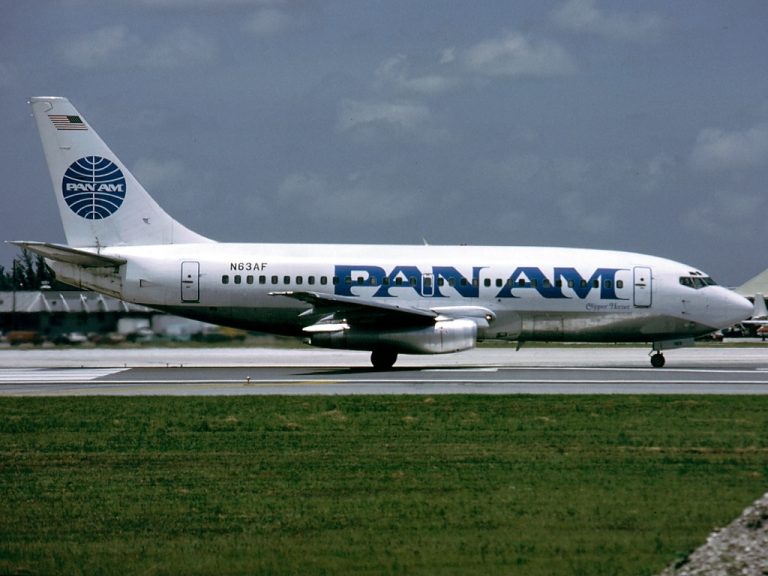Over three decades ago, the world witnessed one of the most unforgettable airline collapse—the collapse of once the world’s leading business, Pan American Airways.
In this article, we discuss the reasons leading to the Pan Am Airlines collapse.
The happy time of Pan Am
Pan Am was a pioneering airline in the late 1950s and early 1970s. They were the first airline company to provide regularly scheduled international flights.
And by 1958, they had become the world’s most experienced airline, with regular flights to every continent (except Antarctica).
Pan Am’s advanced fleet of pressurized aircraft could travel smoothly above turbulent weather, providing a comfortable experience for passengers.
Its luxurious cabins were serviced by a multilingual, college-educated flight crew who provided luxurious meals.
On October 26, 1958, it also became the first American airline to operate a jet aircraft. In 1970, Pan Am carried 11 million passengers to 86 countries worldwide.
But everything started falling apart soon! Let’s trace the Pan Am Airlines collapse.
What happened to the airline Pan Am?
1. Regulatory Challenges
One of the reasons for the company’s downfall was the United States government’s refusal to enable Pan Am to establish a connecting domestic route network in the late 1940s.
This occurred at a time when domestic-based Trans World Airways and several other emerging foreign carriers were granted international route control over most of the routes pioneered by Pan Am.
It marked the beginning of Pan Am’s demise.
2. Terrorism Incidents
Repeated international terrorist attacks against US policy abroad, often directly targeting Pan Am, culminated in the 1988 Clipper 103 disaster.
Also known as the Lockerbie bombing, the Pan Am Flight 103 became the target of a terrorist attack. A bomb placed in the flight detonated over Lockerbie, Scotland.
All 259 people on board were killed, and 11 individuals on the ground also died.
This tragedy became one of the major reasons behind the airline collapse.
3. Increased Competition
The Airline Deregulation Act was proposed in 1978 by President Jimmy Carter. This legislation reduced the government’s control over several significant aspects of the aviation sector.
Before deregulation, internal interstate routes were governed by the Civil Aeronautics Board (CAB).
The Deregulation Act offered operators more freedom and control over their services. Notably, the changing circumstances made it easier for startups to achieve success.
While Southwest Airlines and other up-and-coming carriers would profit from the change, established powerhouses found it difficult to adjust to the new circumstances.
Pan Am started to experience trouble keeping up with the entrants to the market.
4. Growing Costs of Fuel
In addition, the aviation sector suffered from the 1970s’ multiple oil crises. The first crisis emerged in October 1973 after the members of the Organization of Arab Petroleum Exporting Countries (OAPEC) declared an oil embargo, causing the price of jet fuel to increase dramatically.
Pan Am was practically forced to depend on expensive foreign fuel.
In the year following the embargo, the company’s cost sheet increased by about $200 million as a result of the rise in fuel costs.
5. Financial Mismanagement
As fuel costs continued to disrupt operations and global conflicts persisted into the 1980s, Pan Am’s performance started declining.
And the situation was worsened by poor management choices, such as spending too much to acquire Miami’s National Airlines for domestic routes.
During the 1980s, Pan Am sold several valuable properties to reduce its losses.
For example, In 1986, the airline sold its Pacific Division to United Airlines, handing over valuable assets such as planes, gates, landing rights, and contracts to a crucial competitor.
Thomas Plaskett, the Chairman of Pan Am, stated that the company’s filing for bankruptcy was the beginning of a new era and a chance to move past its troubled history. According to The Washington Post in 1991,
“The 63-year-old carrier has spent much of the last decade on the verge of financial catastrophe, difficulties that forced it to sell some of its most valuable assets, including the Intercontinental Hotel in New York, where today’s press conference was held; the airline’s Pacific division; its landmark Manhattan office building; and its London routes.”
The Airline Collapse in a Nutshell
The airline collapse happened due to rising fuel costs and a lack of innovation. In 1988, the airline also experienced several public relations disasters.
Pan Am B747 had a crash in Lockerbie in that same year. This resulted in a $300 million lawsuit and an additional fine from the FAA for 19 security flaws.
After that, Delta Airlines purchased the majority of Pan Am for $1.4 billion, acquiring its European routes, northeastern shuttle routes, 45 jets, Frankfurt mini-hub, and flagship Pan Am Worldport terminal at JFK International Airport.
Lessons for Business Leaders
What happened to Panama serves as a cautionary tale to all the business leaders.
For any business to stay ahead in the growing competition and changing market trends, it is important to capture as many ideas as possible. And a professional idea management tool that integrates with the existing technology stack with minimal uptake time.
An idea management software like InspireIP not only simplifies the process of idea generation but also helps in:
- creating an innovation culture,
- promoting employee innovation,
- streamlineing innovation management.



